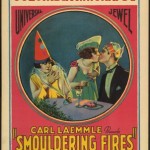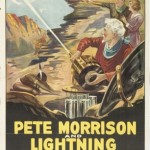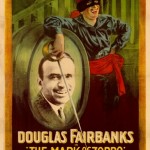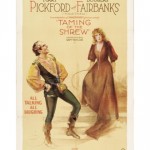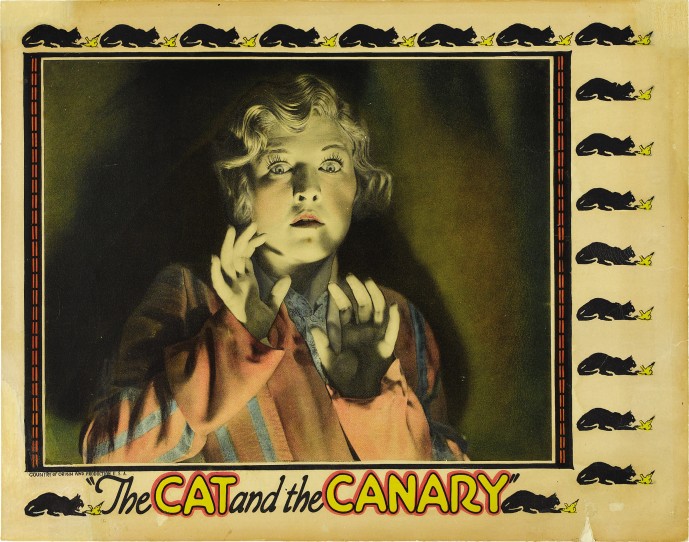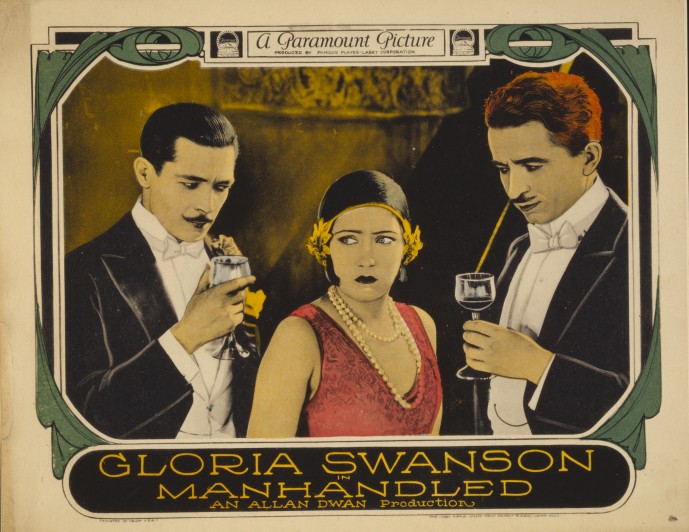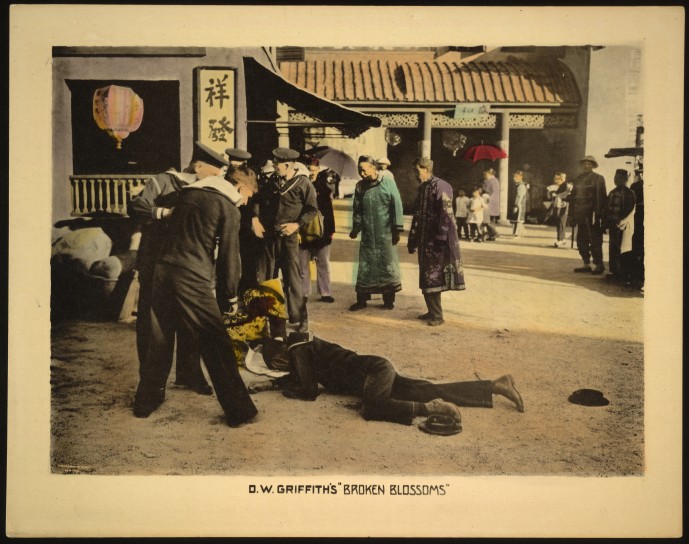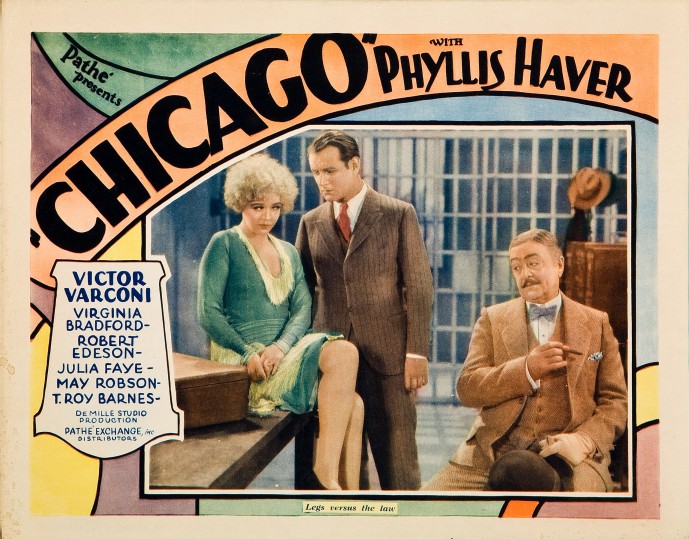Click here to print
The Deafening Silence of Early American Film
posted December 18, 2013
A Library of Congress report documents authoritatively what film archivists have long known: Shockingly little of the nation’s cinema inheritance remains.
n
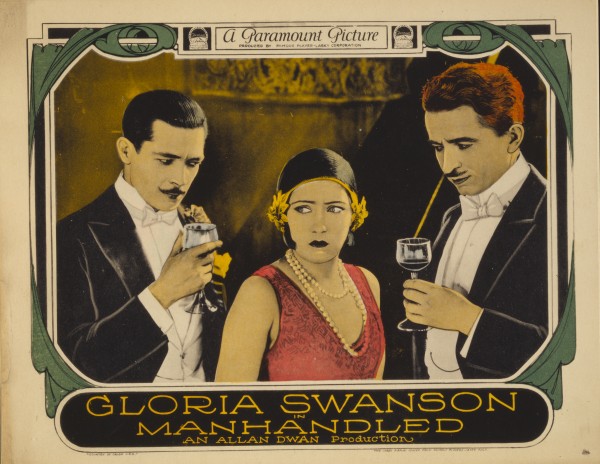
“Manhandled” (1924) exists only in a 16mm Kodascope home library print.
With American feature films pouring into the market every year in their hundreds, it can be all too easy to overlook a sorry reality: the silent films of the early 20th century that laid the foundations for the movie industry are for the most part lost.
That sorry state of affairs becomes known to American film buffs early in their fascination. They learn that the losses occurred for a variety of reasons. Among those are that the nitrate film stock used during the first decades of the film industry was vulnerable to fire and deterioration. Film fans also quickly discover that the film studios neglected or blithely destroyed hundreds of prints and negatives.
The roll call of the dead is long, and its recitation pains film aficionados. Want to see Lon Chaney’s London After Midnight (1927), or any of the four Clara Bow’s feature films produced in 1928 including Ladies of the Mob, or 11 of the 16 Will Rogers silent features?
Sorry.
In fact, about 70 percent of feature-length silent films made in America are gone. Some of the lack of care occurred decades ago. And prospects for recovery of films don’t improve as time passes. That sad reality is all too familiar, these days, to anyone alert to so important an issue in American cultural history. And it was the key message of a report released earlier this month (December 2013) by the Library of Congress.
Only 14 percent—about 1,575 titles—of the feature films produced and distributed in the United States between 1912 and 1929 exist in their original format. Five percent of those that survived in their original 35 mm format are incomplete, while 11 percent of the films that are complete exist only as foreign versions or in lower-quality formats.
“The loss of American silent-era feature films constitutes an alarming and irretrievable loss to our nation’s cultural record,” said Librarian of Congress James H. Billington. “We have lost most of the creative record from the era that brought American movies to the pinnacle of world cinematic achievement in the 20th century.”
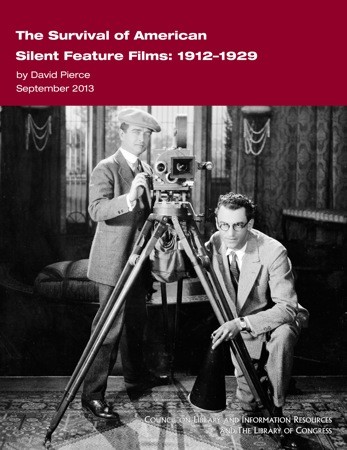 The Library calls the study — “The Survival of American Silent Feature Films: 1912-1929” — the first comprehensive survey of American feature films that survived the silent era of motion pictures. It notes that earlier documentation had established that 10,919 silent feature films of American origin were released between 1912 and 1929; but no definitive, systematic study had been made of how many of these films still exist, nor of which film archives and private collections held surviving elements.
The Library calls the study — “The Survival of American Silent Feature Films: 1912-1929” — the first comprehensive survey of American feature films that survived the silent era of motion pictures. It notes that earlier documentation had established that 10,919 silent feature films of American origin were released between 1912 and 1929; but no definitive, systematic study had been made of how many of these films still exist, nor of which film archives and private collections held surviving elements.
Rather than eulogize American silent film, Pierce’s Library of Congress report alerts readers to where remaining films are, and at the same time seeks to raise awareness of where others films may yet be lurking. It calls for collaboration between archives and the film industry, which has been a hallmark of efforts sparked by the federal National Film Preservation Act of 1988. The legislation set up a National Film Preservation Board (NFPB) of figures from the film industry, and directed the Library of Congress to work with them to do what it could to stem the loss of the country’s film heritage. The Library has made it a priority to support projects that investigate American-film survival.
The Board commissioned historian-archivist David Pierce to undertake the current study, which the Council on Library and Information Resources (CLIR) has published and made freely available online. Pierce is a well-regarded consultant and scholar of copyright issues associated with motion pictures. During the years 2001-2004, he worked at the British Film Institute as head of preservation and then curator of the National Film and Television Archive. He led the Archive’s restoration of F.W. Murnau’s 1927 film, Sunrise, in collaboration with the Academy Film Archive and Twentieth Century Fox.
Pierce also is the founder of the Media History Digital Library, a non-profit initiative that is digitizing and placing online collections of classic motion picture and broadcasting periodicals that are in the public domain – 800,000 pages, and counting. (If you want to read what Photoplay published in 1919, MHDL is your go-to source: You can learn, for example, “How the Motion Picture Saved the World!”)
Pierce has prepared an inventory database of information on archival, commercial, and private holdings — who has custody of the films, how complete they are, the films’ formats, location of best surviving copy… He also suggests that the database can serve as a resource for anyone attempting to locate, or liable to stumble upon, caches of films such as have been discovered in recent years in several countries — in, for example, New Zealand’s national film archives.
{Click on an image to expand}
Foreign archives and collections remain among the best hopes for finding and repatriating lost American films, according to Gregory Lukow, chief of the National Audio Visual Conservation Center-Packard Campus: “Countless films would no longer exist if not for the heroic efforts made by these overseas archivists who have played a major role in preserving not only their own national heritage, but also that of the United States.”
Due to their popularity around the world, many American films were shipped for screening in other countries, and reels were never returned – largely because most studios were not much fussed. Pierce reports that the Czech Republic’s Národní Filmovy Archiv has the largest collection of American silent films outside the United States. Foreign archives often hold copies of films that are more complete than anything known in the U.S., itself. This has been one driving force behind various repatriation projects, including one begun in 2010 between Russia’s Gosfilmofond and the U.S. Library of Congress.
The hard facts that Pierce presents in his report are not particularly heartening. He writes, for example, that:
- 14 percent of the feature films produced domestically from 1912-1929 survive in their original-release 35 mm format.
- 11 percent of the films are complete as foreign versions or on lower-quality formats, such as 28 mm or 16 mm.
- 5 percent are incomplete, either missing a portion of the film or existing only as an abridged version.
- Of the more 3,300 films that survived in any form, 26 percent are in other countries.
Some actors of the silent era had the forethought to take the matter of preservation into their own hands. Most of the films in which the legendary Mary Pickford acted have survived because she paid for them to be properly handled. Unfortunately, several of her earliest films did not come under her care, and disappeared — but in 2006 one eventually turned up in an old barn. It was her 1911 short, Their First Misunderstanding, her first credit.
Pickford’s rediscovered film is now in the care of the Library of Congress, which holds the world’s largest collection of American silent features. More than half the silents in its collection cannot be found anywhere else.
Few American studios did a good job, when it came to ensuring their films’ survival. However, in the plus column “one studio stands out,” writes Pierce. “Starting in the early 1960s, Metro-Goldwyn-Mayer (MGM) preserved at the corporation’s expense 113 silent features produced or distributed by MGM or its predecessor companies. Starting in the 1930s, MGM also gave prints or negatives for 120 silent feature films to American archives, primarily George Eastman House. The survival rate of silent films produced by MGM after its founding in 1924 is 68 percent, the highest of any studio. For other companies, the proportion is much lower.”
What to do? Pierce makes a variety of recommendations. These include:
- Develop a coordinated national program to repatriate U.S. feature films from foreign archives.
- Collaborate with studios and rights-holders to acquire archival master film elements on unique titles.
- Coordinate efforts by American archives and collectors to preserve silent films that survive only in lower-quality formats.
Pierce also calls on archives and other film holders to screen silent feature films more actively and frequently.
That, of course, makes perfect sense. Nothing would better serve to demonstrate to more Americans what it is that they risk losing, forever.
Printed from Moving Image Archive News: https://www.movingimagearchivenews.org
URL to article: https://www.movingimagearchivenews.org/the-deafening-silence-of-early-american-film/
Click here to print

